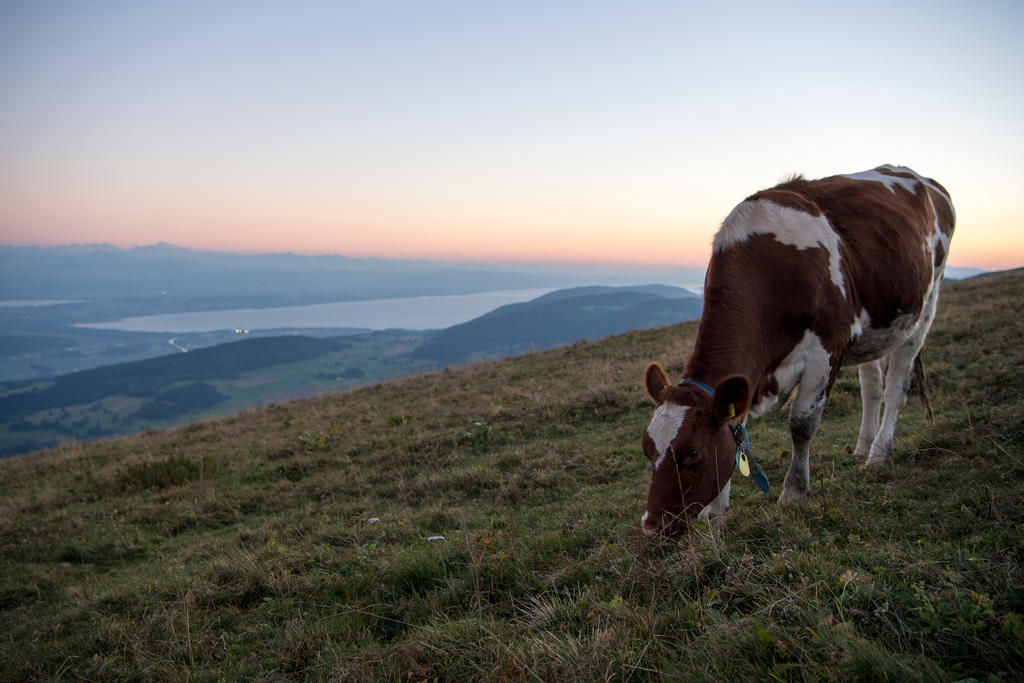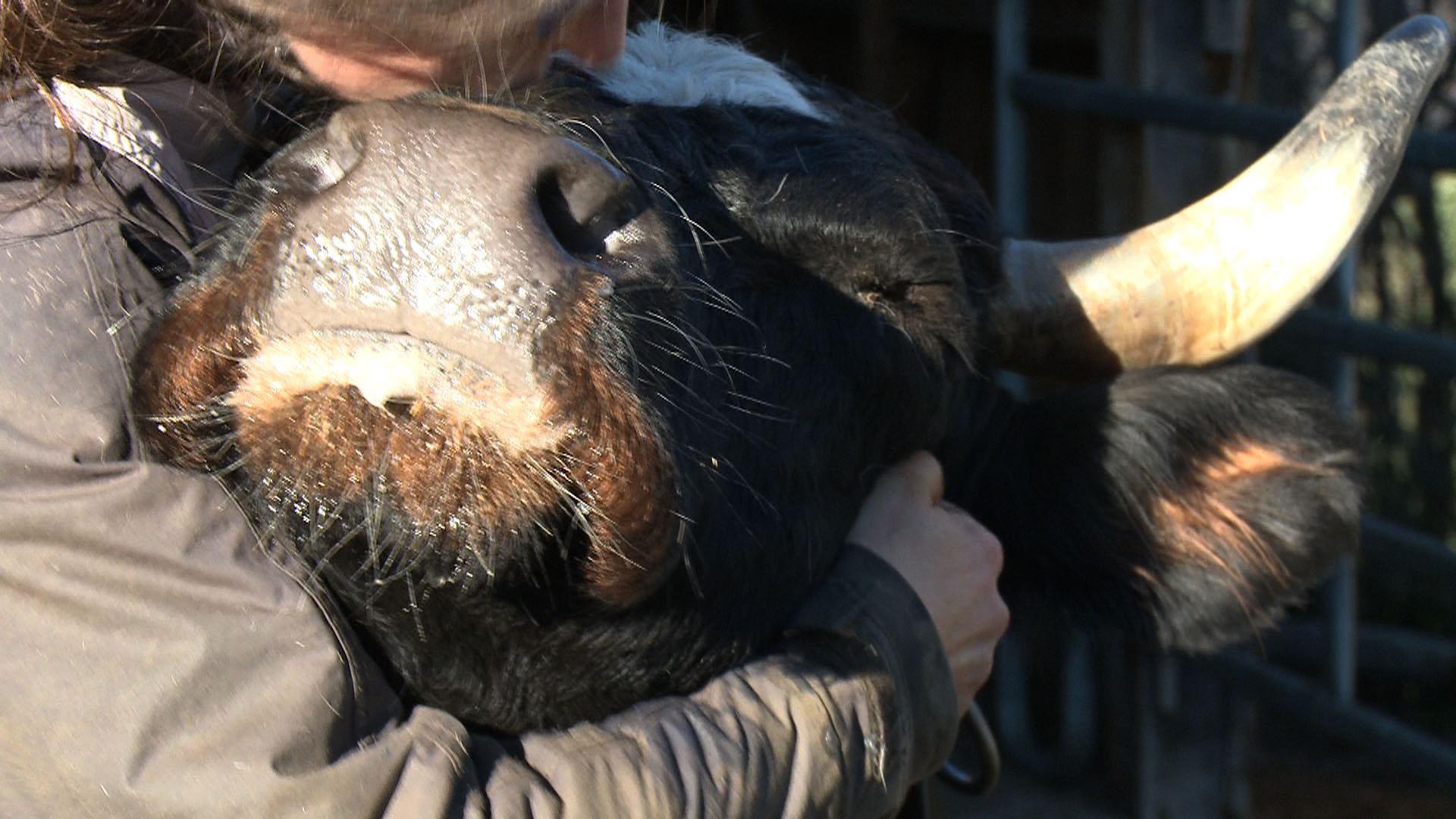Swiss start-ups hope to slow climate change with cow burps

Could changing what cows eat help keep the planet from warming? Several Swiss companies have created feed additives that they claim reduce methane emissions, but the science hasn’t convinced everyone yet.
Cattle farms represent the idyllic image of Swiss life: green meadows dotted with wildflowers and grazing cattle with bells around their necks, all set against dramatic Alpine scenery. But every year, millions of litres of methane emanate from these pastures. It’s a greenhouse gas whose 100-year impact on the atmosphere is about 28 times that of carbon dioxide,External link making it a significant contributor to climate change.
“If you took all the cows on Earth…they would be the third-largest [greenhouse gas] emitters in the world, behind China and the US,” says Michael Mathres, head of strategic projects for MootralExternal link, an agritech company headquartered near Geneva. He says the agriculture and food industries have been “greatly under-addressed” when it comes to tackling climate change.
Livestock is responsible for 14% of greenhouse gas emissions, two-thirds of that from cattle, according to the United Nations Food and Agriculture OrganizationExternal link.
Agriculture is also responsible for about 13% of total greenhouse gas emissions in Switzerland.
Climate change from the gut
The first chamber of a cow’s four-chambered stomach, the rumen, is filled with a universe of microbes that ferment food, making it easier to digest. During digestion, methane forms and escapes mainly through the cow’s muzzle when it burps.
On average, a cow may burp about once a minuteExternal link, releasing about 500 litres of odourless methane from its mouth and nose every day.
Mootral Ruminant, a product due to be released by the end of the year, is derived from garlic and citrus. When added to a cow’s daily diet, the company claims it can help cut methane emissions by 30% or more.
Agolin, another Swiss company, sells a feed additive made from a clove and coriander seed known as Agolin RuminantExternal link. It’s marketed as a way to increase a cow’s milk production, which improves a herd’s efficiency and therefore reduces methane, according to Agolin Managing Director Kurt Schaller. He says Agolin’s product cuts methane emissions by six to 30%.
Feed additives work by altering the bacterial environment in the rumen, says Schaller. According to his company, the rumen of cows fed Agolin Ruminant contained a different makeup of bacteria and protozoa than the control cows’ rumen.
According to Schaller, about one million cows, mostly in Europe, eat feed containing Agolin Ruminant.
Mootral says its product reduces methane production by suppressing a high-methane-producing organism called Methanobrevibacter. The study supporting its claim was paid for by Neem Biotech a UK-based pharmaceutical research company that helped develop Mootral.
Put to the test
What do other studies and trials conclude about feed additives?
For Agolin Ruminant, a trial shows methane reduction in live animals for the six weeks the supplement was given. (Agolin’s technical director, Beatrice Zweifel, is listed as a study author). A different study found that the methane-reducing effects faded over the course of the approximately three-week experiment.
Agolin’s Schaller says a larger study with live animals shows positive results, but details are classified pending upcoming publication.
Agolin’s results were enough to convince the Carbon TrustExternal link, a London-based environmental consulting firm. In 2018, the Carbon Trust provided Agolin with a certificate allowing the feed industry using its product to claim a 10% reduction in greenhouse gases.
A research team at AgroscopeExternal link, Switzerland’s federal centre for agricultural research, studied pressed linseed and ground rapeseed as cattle feed supplements. Both triggered a 7% reduction in overall methane and a 15 to 17% drop in emissions per kilogram of milk produced.
But Daniel Bretscher, a research associate at Agroscope who was not part of the centre’s feed supplement study, says he’s not optimistic about additives as a means to reduce greenhouse gases.
“Changing [the nature of ruminants] cannot be done by simple engineering, like making a car more efficient,” Bretscher says, adding that changing processes that evolved over thousands of years could result in unwanted side effects. For Bretscher, the focus to reduce emissions should be on “the reduction of animal-based foods in our diet”.
Farmers and funding
Farmers are keeping an eye on research and product development when it comes to feed additives, says Fabienne Thomas, the head of energy and environment at the Swiss Farmers’ UnionExternal link. She says farmers are wary, though, of the prospect of the government requiring feed additives, since they believe too many government-mandated regulations could hurt their livelihoods.
“It’s a price question,” says Thomas. “If you have more requirements, more regulations, then it’s more expensive to produce. Then you are not competitive any more with other European producers.”
Could feed additives be subsidised by the Swiss government? Daniel Felder, the Federal Department of Agriculture’s scientific officer responsible for climate action, says no feed additive products to cut methane have been approved yet for federal compensation. There is something in the pipeline, Felder says, “but the quality of the request is not yet sufficient”.
“I think it will take a bit more time until such a program will be approved,” Felder says, citing several factors to be considered, including differences in cattle feed from farm to farm, production of feed, and challenges in monitoring levels of greenhouse gas reduction.
Where’s the potential?
Whether feed additives are included in government measures to reduce emissions will depend on further study results. But Agroscope’s Bretscher says it’s difficult to know if methane study findings are statistically significant, since individual animals produce different amounts of methane. And systems for measuring methane, such as enclosed chambers or a mobile monitoring devices strapped to the cow, are associated with high levels of statistical uncertainty.
Bretscher also points out that any greenhouse gas reductions from feed supplements could be offset by the energy it takes to grow those supplements and by higher emissions from manure management. And over time, microbiomes in the cow’s rumen can adapt to changes from feed supplements, he says, making them less effective.
The agriculture department’s Felder says the largest potential for cutting greenhouse gases in agriculture is further reducing animal numbers.
Switzerland saw a significant reduction in greenhouse gas emissions in the 1990s, he says, when agriculture policy allowed for direct payments to farmers if they fulfilled certain ecological standards. This resulted in a decrease in the number of cattle from about 1.9 million to about 1.6 million.
It comes down to a difficult reality, Felder says.
“In order to meet the sustainability and climate targets, it will be necessary that we eat less meat and produce fewer animal-based foods.”
Climate change: focus on agriculture
For the first time, Switzerland’s CO2 ActExternal link is being revised to include agriculture-specific greenhouse gas reduction targets that will come into effect starting in 2021.
Farmers are already managing emissions by rotating cropsExternal link and covering the soil to help capture C02, according to Thomas of the Farmers’ Union. Additionally, they can use products like ENTEC 26External link, a nitrogen-fixing fertiliser available at a discounted price through Switzerland’s compensation programmExternal linke for CO2 emissions.
And a methane-reduction project called Climate Friendly MilkExternal link, funded by Switzerland-based Nestlé and the Federal Office of Agriculture, encourages Swiss farmers supplying Nestlé to prolong the lives of dairy cattle to at least five 300-day lactation cycles, up from the typical three cycles. This means a 5% reduction in greenhouse gas emissions per kilogram of milk, says Nestlé spokeswoman Marianna Fellmann, and a reduction of roughly 150,000 tons of CO2 per year if all Swiss dairy farmers participated.
“This is equivalent to 15% of the [new] reduction targets for agriculture,” she says.

In compliance with the JTI standards
More: SWI swissinfo.ch certified by the Journalism Trust Initiative










Join the conversation!